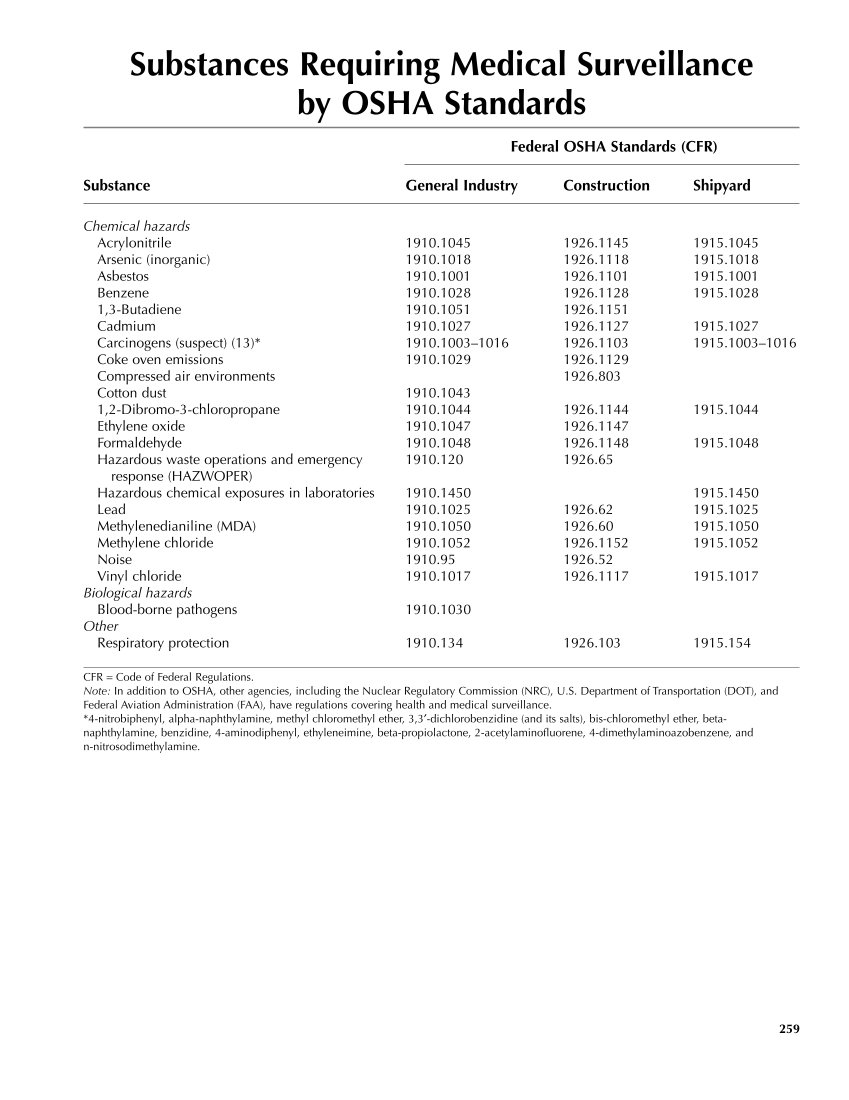Substances Requiring Medical Surveillance by OSHA Standards Federal OSHA Standards (CFR) Substance General Industry Construction Shipyard Chemical hazards Acrylonitrile 1910.1045 1926.1145 1915.1045 Arsenic (inorganic) 1910.1018 1926.1118 1915.1018 Asbestos 1910.1001 1926.1101 1915.1001 Benzene 1910.1028 1926.1128 1915.1028 1,3-Butadiene 1910.1051 1926.1151 Cadmium 1910.1027 1926.1127 1915.1027 Carcinogens (suspect) (13)* 1910.1003–1016 1926.1103 1915.1003–1016 Coke oven emissions 1910.1029 1926.1129 Compressed air environments 1926.803 Cotton dust 1910.1043 1,2-Dibromo-3-chloropropane 1910.1044 1926.1144 1915.1044 Ethylene oxide 1910.1047 1926.1147 Formaldehyde 1910.1048 1926.1148 1915.1048 Hazardous waste operations and emergency 1910.120 1926.65 response (HAZWOPER) Hazardous chemical exposures in laboratories 1910.1450 1915.1450 Lead 1910.1025 1926.62 1915.1025 Methylenedianiline (MDA) 1910.1050 1926.60 1915.1050 Methylene chloride 1910.1052 1926.1152 1915.1052 Noise 1910.95 1926.52 Vinyl chloride 1910.1017 1926.1117 1915.1017 Biological hazards Blood-borne pathogens 1910.1030 Other Respiratory protection 1910.134 1926.103 1915.154 CFR = Code of Federal Regulations. Note: In addition to OSHA, other agencies, including the Nuclear Regulatory Commission (NRC), U.S. Department of Transportation (DOT), and Federal Aviation Administration (FAA), have regulations covering health and medical surveillance. *4-nitrobiphenyl, alpha-naphthylamine, methyl chloromethyl ether, 3,3′-dichlorobenzidine (and its salts), bis-chloromethyl ether, beta- naphthylamine, benzidine, 4-aminodiphenyl, ethyleneimine, beta-propiolactone, 2-acetylaminofluorene, 4-dimethylaminoazobenzene, and n-nitrosodimethylamine. 259
Purchased from OEM Press by (ge corporate access). (C) 2013 OEM Health Information, Inc. All rights reserved.












































































































































































































































































































































































































































